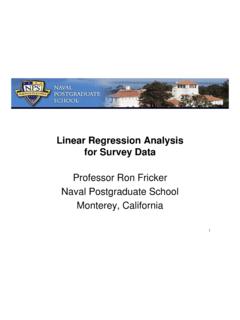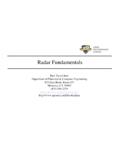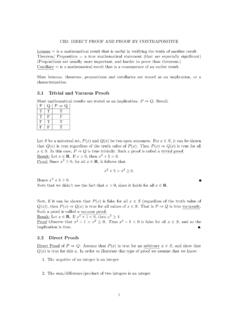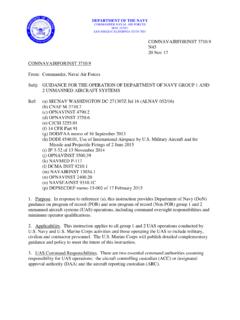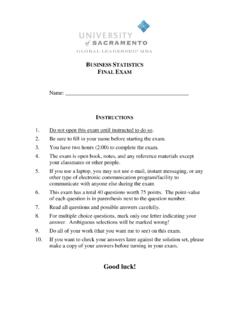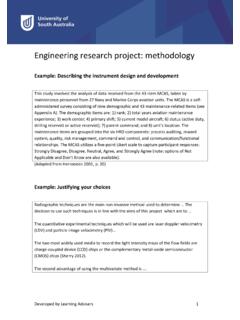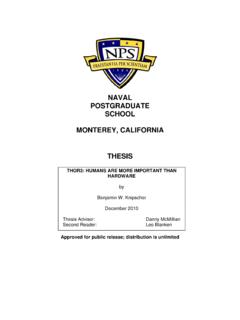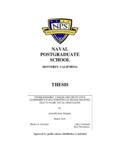Transcription of Target Populations, Sampling Frames, and Coverage Error
1 1 Target Populations, Sampling Frames, and Coverage ErrorProfessor Ron FrickerNaval postgraduate SchoolMonterey, California12 Goals for this Lecture Define survey Sampling terms, including Target population, survey population, Sampling frame, element Coverage , undercoverage, ineligible units Discuss frame Coverage issues and some solutions Discuss Sampling issues related to web-based and e-mail-based surveys When can an all electronic survey approach work and when not? What are the (current) difficulties with using these survey modes for general populations?23 Terminology (1) The Target populationis the group of elements to which the researcher wants to make inference At least theoretically, the population is finite and can be counted The fundamental units of the population are elements Often, elements are persons They can also be households, housing units, parts of an organization, (2) The survey populationis a subset of the Target population (often resulting from practical survey considerations)
2 Using RDD, the survey population is all US households with a landline In CES, employers have to be in business for several months The Sampling frameis used to identify the elements of the population Via explicit or implicit enumeration5 Coverage Properties of Sampling Frames A Target population element that is in the Sampling frame is covered Undercoverageis the fraction of the total population not covered by the Sampling frame Ineligible unitsare those elements in the Sampling frame that are not part of the total population6 Sampling Frame Issues A Sampling frame is perfectif there is a one-to-one mapping from frame to population elements Duplicationoccurs when multiple frame elements map to one total population
3 Element Clusteringoccurs when multiple total population elements map to one frame element7 Frame Issues for Household and Person-level Surveys (1) Phone number-based framesfor Sampling households and/or persons Issues: Undercoverageof households without landlines A growing problem with proliferation of cell phones Overcoveragefor households with more than one landline Duplication when using lists if same number listed under multiple names With electronic lists, can sort by phone number and remove duplicate phone numbers Can also manage problem during Sampling Screening required for non-residential phone numbers8 Frame Issues for Household and Person-level Surveys (2)
4 Area framesfor Sampling households and/or persons Area frames require multi-stage Sampling First sample areas Then make listing of addresses in sampled areas Then enumerate and sample individuals Issues: Undercoverageif list of addresses within area incomplete Duplication if people have more than one residence Clustering, since housing units contain multiple people9 Frame Issues for Household and Person-level Surveys (3) Web or e-mail surveys for households and/or persons Issues: No global list (frame) exists for general population Sampling frames for e-mail only exist for specific organizations No practical equivalent of RDD exists Most survey organizations classify sending unsolicited e-mail as unethical ( , spam) More at the end of the Issues for Customer, Employee, Other Members of Organization Surveys Studies of customers, employees, members of organizations tend to use list frames E-mail contact/surveys often feasible for these groups Undercoveragecan be an issue if lists are out-of-date Also, depending on how list generated, can miss portions of population ( , payroll-based list misses volunteers)
5 Inclusion of ineligible units can also be an issue Duplication can be an issue, but likely rare for employee, organization-based lists For customer surveys, if list based on transactions, care must be given to duplicates and what resulting frame actually represents11 Frame Issues for Organizational Surveys Organizational populations very diverse Sampling frames are often lists of units For business units, significant variation in size can be an issue May need to stratify on size and oversample In commercial world, population is likely to be highly dynamic Business come and go, merge, etc. Frame may need constant updating 12 Frame Issues for Event-based Surveys Surveys may Target events Periods of deployment, enrollment at NPS, etc.
6 Often begin with a frame of persons and then screen for event Some persons may have experienced multiple events, so clustering can occur Can also use frame of time units , sample customers exiting a store at certain times (of the day, of the week, of the year, etc) Time use surveys sample at random points in time13 Reducing Undercoverage There are remedies for reducing Sampling frame problems But they do not always eliminate undercoverage Also, note that what is relevant is how undercoverageaffects the sample statistics For some it may be negligible and others significant Can represent Coverage bias as Note it s a function of both undercoverageamount and difference between the means()CCUUYYYYN = 1314 Strategy: Multiple Frame Design Idea.
7 Supplement the principle frame with one or more auxiliary frames , supplement RDD with area Sampling to get at those without a landline phone Must adjust results to account for those that can be selected in both frames Multiple frames may require multiple modes Much research still required for problem of multiple frames combined with multiple modes15 Strategy: Broaden Definition of Who Can Be in Sampling Frame Idea: Broaden the definition of who can be in the Sampling frame, then screen out as necessary Incurs extra costs and requires additional effort Example: Surveys of housing units, where an individual is asked who lives in the house, frequently misses some people Rather than ask Who lives here?
8 Ask broader questions about who slept or ate in the unit the previous day, who has a key, who receives mail there, etc. Then use other questions to screen out as necessary Issue: Since these questions have to come first, can increase number of survey refusals / nonresponse16 Strategy: The Half-Open Interval Idea: Supplement frame with information gained during selection process Useful for lists that may be missing some entries Example: When Sampling households, the Sampling unit is not the address, but all addresses from the one selected up to the next one on the list17 Strategy: Multiplicity Sampling Idea: Each unit selected into the sample is asked about members of a well-defined network , An individual is contacted via RDD and asked questions about his/her adult siblings Issue: Individuals may have multiple chances of being selected Need to appropriately weight to adjust Similar idea: snowball Sampling Locate additional potential survey respondents via current respondents Useful for rare conditions where Sampling of general population would be inefficient Non-probability method, so inference difficult/impossible18 Doesn t the Web Solve Everything?
9 Today anyone can do a web survey:1819 Types of Internet-based Surveys Sampling Method Web E-mail Probability-based Surveys using a list-based Sampling frame 9 9 Surveys using non-list-based random Sampling 9 9 Intercept (pop-up) surveys 9 Mixed mode surveys with Internet-based option 9 9 Pre-recruited panel surveys 9 9 Non-probability Entertainment polls 9 Unrestricted self-selected surveys 9 Surveys using Harvested E-mail Lists (and Data) 9 9 Surveys using volunteer (opt-in) panels 9 Table 2. Types of Internet-based surveys and associated Sampling methods. 1920 Internet Surveys Pose Significant Challenges for General Populations Internet users do not reflect the general population Frame and Coverage bias Very hard to impossible to generate a Sampling frame There is no master list of e-mail addresses Recruiting respondents via the web can introduce bias Unethical/illegal to solicit survey participation via e-mail (spam)2021 Unsolicited E-mail is Spam 3.
10 Internet Research a. The unique characteristics of internet research require specific notice that the principle of respondent privacy applies to this new technology and data collection methodology. The general principle of this section of the Code is that survey research organizations will not use unsolicited emails to recruit respondents for surveys. (1) Research organizations are required to verify that individuals contacted for research by email have a reasonable expectation that they will receive email contact for research. Such agreement can be assumed when ALL of the following conditions exist. a. A substantive pre-existing relationship exists between the individuals contacted and the research organization, the client or the list owners contracting the research (the latter being so identified); b.
